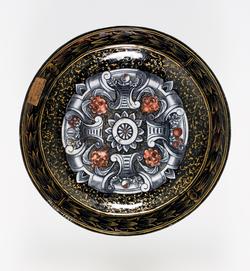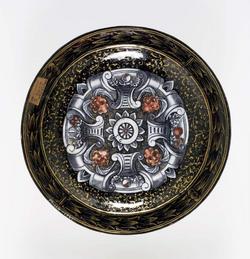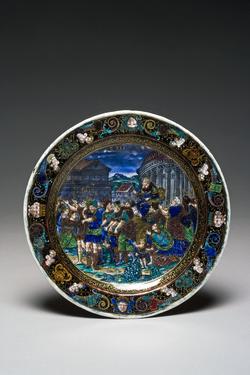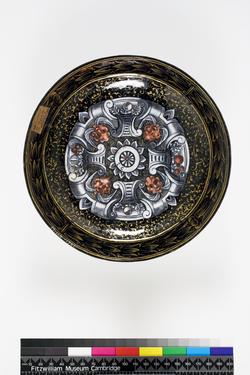Current Location: Gallery 32 (Rothschild)
Titles
The Triumph of Joseph
Maker(s)
Maker:
Court dit Vigier, Jean I
(Possibly)
Maker:
Court dit Vigier, Jean II
(Possibly)
Entities
Categories
Description
Copper, enamelled in polychrome and gilded with the Triumph of Joseph'; reverse enamelled en grisaille and gilded with masks, strapwork and arabesques, and initialled "I.C"
Circular copper plate with slightly raised edge, narrow rim, and shallow well with curved sides. The plate has a black ground. The central design is enamelled over a white ground in translucent blue, turquoise, green, yellow, and mulberry enamels over silver foils, and opaque white, flesh-pink and black highlighted with gold. The cavetto has a black ground painted in gold. The rim has a black ground except for the foiled areas and the flesh areas which have a white preparation. The edge is white. The reverse is enamelled in grisaille with dark salmon-pink on a black ground painted in gold The underside of the rim has a black ground painted in gold.
The central design shows Joseph riding in Pharaoh's Chariot known as The Triumph of Joseph. Joseph, is seated a chariot on the right, with a crowd of Egyptians in front of him. In the background there are three buildings: on the right, a circular domed building with Corinthian columns round its circumference; in the middle, a smaller low building with a sloping roof, and on the left, a rectangular building with a triangular gable and arcaded lower storey. "G.XLI" is inscribed in gold on the sky. The sides are decorated with gold foliated scrolls between horizontal bands. On the rim are two different female masks wearing fabric headdresses, and two different crowned male masks, separated by vases flanked by pairs of tritons with tablets over their curly tails, with sprays of gold foliage in the spaces.
The reverse is enamelled en grisaille. In the centre there is a white flowerhead comprising a rosette, a broad circle and twelve petals, Around this are two dark salmon-pink masks without hair and two with hair, with drapery issuing from their mouths, confined by broad strapwork and fruit on stems. The black ground is decorated with gold arabesques, and on the rim, thee is a wreath of gold leaves and berries between gold bands. The mark "I.C." is painted in black on a white circle surrounding the central rosette.
Notes
History note: Thomas Hope (1769-1831) before 1826; Henry Thomas Hope (1808-62); Mrs H.T. Hope (d. 1887); her daughter Henrietta Adele Hope (1843-1913), 6th Duchess of Newcastle; her son, Henry Pelham Archibald Douglas Pelham-Clinton (1864-1928), 7th Duke of Newcastle Christie’s, 7 July 1921, Catalogue of fine old English silver-gilt plate, Limoges enamels, old Italian majolica and porcelain, the property of his grace the Duke of Newcastle, and removed from Clumber, Worksop, p. 19, lot 110, illustrated; sold for £780. George A. Lockett; sold Christie’s, 12 June 1942, The Choice Collection of objects of Art and Furniture formed by the late George A. Lockett, Esq., p. 22, lot 203, illustrated; Mallett & Sons, London; purchased in September 1942 by Louis C.G. Clarke, MA, Cambridge.
Legal notes
Louis.C.G. Clarke Bequest, 1960
Measurements and weight
Diameter: 19.9 cm
Height: 2.2 cm
Acquisition and important dates
Method of acquisition: Bequeathed
(1960)
by
Clarke, Louis Colville Gray
Dating
16th Century, Late-17th Century, Early
Henry III of France
Henry IV of France
Circa
1585
CE
-
1600
CE
Note
The Biblical story of Joseph told in Genesis, was a common theme for the decoration of domestic objects in France in the second half of the 16th century. Limoges enamellers decorated caskets, ewers, dishes, and small plates with Joseph scenes. Although no complete sets are known, this plate was probably one of a set of twelve each decorated with a different event in the story, beginning when Joseph was already the slave of Potifar in Egypt, and extending from his rejection of the enticements of Potiphar’s wife (Genesis 39.7) to his reconciliation with his brothers (Genesis 45.14-16). Ten of the scenes were closely based on Bernard Salomon's woodcut illustrations to Claude Paradin’s 'Quadrins historiques de la Bible', first published by Jean de Tournes in Lyon in 1553. An augmented edition appeared in 1555, reprinted in 1558 and 1560, and another augmented edition in 1583. Each page had the biblical reference at the top, a woodcut, and an explanatory verse below. Another work of the same type, Guillaume Guéroult’s 'Figures de la Bible illustrées de huictains francoys . . . (Guillaume Roville), Lyons, 1564 (2nd edn, 1565), with illustrations by Pierre Eskrich was used for the 7th and 10th plates in the series, and the 12th has aspects from the woodcuts in both publications. This indicates that the series of plates were made after 1564/65.These books can be viewed online in the Gallica website of the Bibliothèque nationale.
This plate is decorated with the fifth scene in the sequence. The Triumph of Joseph, described in Genesis, Chapter 41, 43: ‘And he [Pharaoh] made him to ride in the second chariot which he had; and they cried before him, Bow the knee: and he made him ruler over all the land of Egypt’. The Biblical reference ‘.G.XLI’ is given above the scene which was copied from a woodcut illustration entitled ‘GENESE XLI’ by Bernard Salomon in Claude Paradin, 'Quadrins Historique de la Bible', Lyon, 1553 or a later edition., . (The 1558 edn is in the Cambridge University Library Keynes, E.3.4, and in the Fitzwilliam Museum Dept. of MSS and Printed Books). At least two more plates are known decorated with this subject, one with a blue ground, in the Musée du Louvre (see Documentation, Baratte, 2000), and one with a manganese-black ground which descended in the family of Lionel de Rothschild (1808-79) and was sold by Sotheby's London in 2003 (see Documentation).
The overall appearance of these plates, the border on the fronts, and the style of grisaille decoration on the reverses, is comparable to a set of plates decorated with scenes from the Life of the Virgin signed' I.C.' . These have the de Vic arms below on the rims, probably for Méry de Vic (d. 1622), who had been resident in Limoges as intendant during 1588 and 1589, while on a mission to restore order in the region for Henry III, and after his assassination in August 1589, had transferred his allegiance to Henry IV. It seems possible that the plates were made about that time, and if not, before 1603 when a change was made to the de Vic arms. In that year, Henry IV granted to Dominic de Vic, a distinguished soldier, administrator and diplomat (d. 1610), and his brother, Méry, the right to add to their arms 'un écusson d’azure chargé d’une fleur de lys d’or et d’une bordure du même' (a blue shield charged with a gold fleur de lys and a border of the same).
The mark ‘I•C’ seems likely to have been a workshop mark used succesively by Jehan or Jean Court dit Vigier I (d. 1592) and his son, Jean Court dit Vigier II (b. c.1575-d. between 1631-5). The issue is complicated by the presence of another Jehan/Jean de Court who witnessed the latter's wedding in 1598, and was therefore probably a relative, and possibly an enameller, and of another enameller, Jehan/Jean Court dit Vigier le jeune who married in 1613, and died between 1627-31, but seems likely to have been too young to have been the decorator of the Joseph Plates. (See Documentation, Beyssi-Cassan, 2006).
School or Style
Renaissance
Mannerism
People, subjects and objects depicted
Components of the work
Foils
composed of
silver
( probably)
Decoration
composed of
enamel
( translucent blue, turquoise, green, yellow, and mulberry; flesh pink, opaque white, grey and black)
gold
Materials used in production
Copper
Techniques used in production
Raising (metal forming process)
: Copper, enamelled in polychrome and grisaille, and gilded. The design in the well is outlined in black and executed in translucent blue, turquoise, green, yellow, and mulberry enamels over silver foils, and flesh pink, opaque white, grey and black enamels over a white preparation, highlighted with gold. The cavetto has a black ground painted in gold. The rim has a black ground except for the foiled areas and the flesh areas which have a white preparation. The edge is white. The reverse is enamelled in grisaille with dark salmon-pink, on a black ground painted in gold The underside of the rim has a black ground painted in gold.
Inscription or legends present
- Text: I•C
- Location: On strapwork on the back
- Method of creation: Painted in black enamel
- Type: Initial
References and bibliographic entries
Identification numbers
Accession number: M.114-1961
Primary reference Number: 139825
Stable URI
Audit data
Created: Saturday 6 August 2011
Updated: Tuesday 26 March 2024
Last processed: Thursday 14 August 2025
Associated departments & institutions
Owner or interested party:
The Fitzwilliam Museum
Associated department:
Applied Arts

 IIIF Manifest
IIIF Manifest








